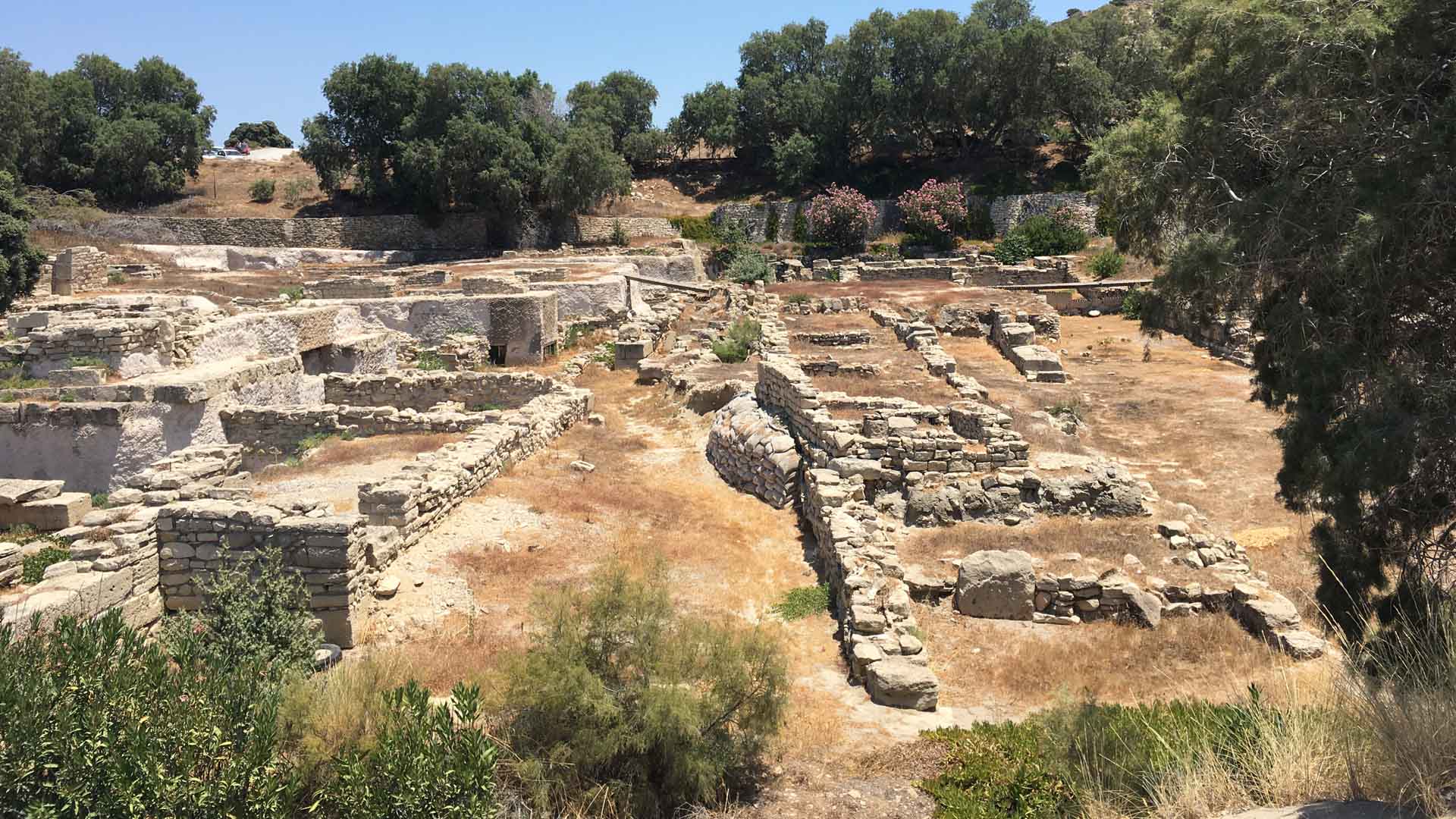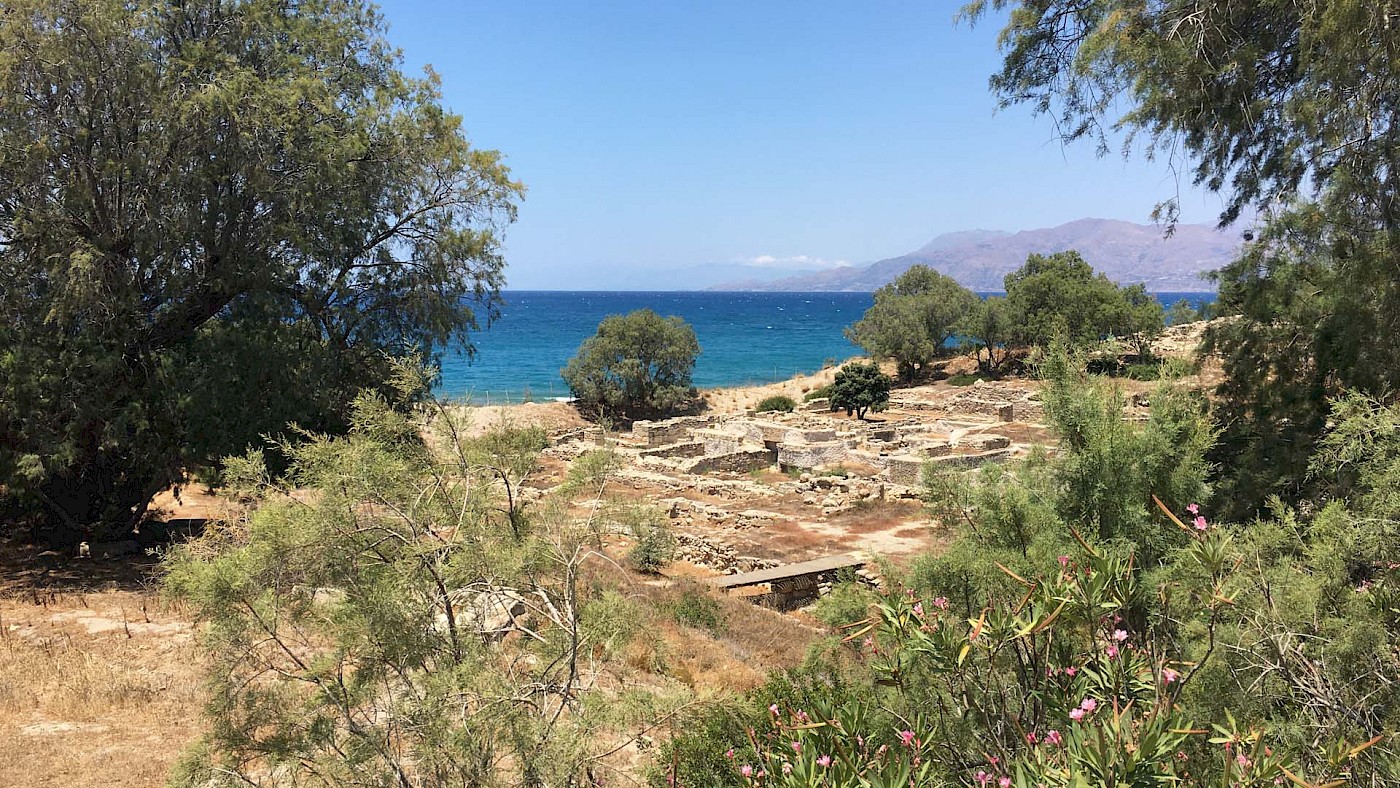The Messara Plain in southern Crete is the largest plain of the island and of key importance for agriculture. It’s no surprise that it also contains a number of important sites, including the court complex at Phaistos and the administrative centre at Agia Triada.
Located on the coast, a little north of Matala, is the archaeological site of Kommos, which together with Phaistos and Agia Triada forms what archaeologists refer to as the Minoan Triangle. These three sites were closely associated with each other, with Kommos functioning as the harbour for Phaistos and/or Agia Triada.
Excavations at this site, located virtually on the beach, started in 1976. The couple Joseph W. and Maria C. Shaw have led the excavations, unearthing the remains of a Minoan harbour. After the end of the Bronze Age, a sanctuary was built on top of the Minoan remains at the end of the eleventh century BC (temple A). New temples and other structures were erected over the course of the next millennium. The site was abandoned in the Roman period.

There is a sign with the site’s name, but further information is lacking. Fortunately, Joseph W. Shaw has written an accessible book on the excavations, Kommos: A Minoan Harbor Town and Greek Sanctuary in Southern Crete (2005). The book also contains photos that offer a better idea of the site and its monumental architecture, some of which has been lost to the sea, as well as plans of houses, photos of a stone press and other objects, as well as restorations of frescoes.
One structure – Building T – unearthed at Kommos is very large: its function is unclear, but the suggestion is that it may have been similar to the court complexes found at the major “palace” sites. This complicates the interpretation of the power dynamics within the Minoan Triangle: what is the relationship between Phaistos and Kommos if the latter was potentially also a political centre? Or was Kommos merely the harbour of Phaistos and was this building used for more limited administrative purposes?
During the Late Bronze Age, a new building was constructed partially over the remains of Building T, dubbed Building P (Late Minoan IIIA2). The structure consists of a number of broad galleries, one next to the other, and each measuring 5.50 metres or more in width and on average around 38.50 metres in length. All of these galleries are roofed and are, in Shaw’s words, “without parallel in Minoan architecture” (2005, p. 39).
These galleries were used for storing something, but what exactly remains a matter of discussion. The most plausible suggestion is that they housed ships. Such shipsheds are known from later periods (e.g. Classical Athens), which look very similar to these Bronze Age examples. In favour of this interpretation are the dimensions of the galleries, as well as the pottery found inside them: hundreds of fragments of so-called short-necked amphoras that could be used to transport goods in bulk.

Kommos is not accessible to the public: fencing keeps visitors out. However, Shaw writes in the foreword to his book that visitors can sometimes gain access to the site by asking the guards at Phaistos. If you happen to stay near the site, I imagine this would be easier to organize: something to try and do in the future.
The ancient walls on the site have been consolidated, which means that they have been reinforced to ensure that they are less likely to crumble over time, exposed as they are to the elements. There are plans to open up the site to the public in the future, but it’s unclear when this will happen. Flanking a popular beach and only minutes away from both Matala and Pitsidia, it seems ideally located as a future tourist destination.
When we were in Crete last summer, we also visited the brand new Archaeological Museum of the Mesara [sic] (Messara and Mesara are both accepted spellings). The museum was opened earlier this year, but was essentially empty. There was an exhibition about seafaring, consisting of models, photos, and a few objects, as well as an photo exhibition about the Minoan Triangle. The museum should eventually house objects from the region and be ready to receive visitors by the beginning of next year.
